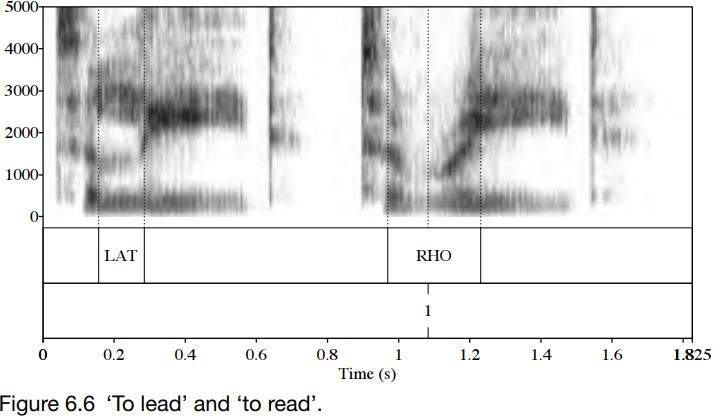


 Grammar
Grammar
 Tenses
Tenses
 Present
Present
 Past
Past
 Future
Future
 Parts Of Speech
Parts Of Speech
 Nouns
Nouns
 Verbs
Verbs
 Adverbs
Adverbs
 Adjectives
Adjectives
 Pronouns
Pronouns
 Pre Position
Pre Position
 Preposition by function
Preposition by function 
 Preposition by construction
Preposition by construction
 Conjunctions
Conjunctions
 Interjections
Interjections
 Grammar Rules
Grammar Rules
 Linguistics
Linguistics
 Semantics
Semantics
 Pragmatics
Pragmatics
 Reading Comprehension
Reading Comprehension|
Read More
Date: 2023-10-25
Date: 20-6-2022
Date: 2023-10-25
|
A common property of rhotics is that they have a low F3 (around 1800 Hz). Because most versions of rhotics involve movement of the tongue body, which is relatively massive and slow to move, their acoustic properties tend to be very extensive in the time domain.
We illustrate this with the approximants [ɹ] and [l]. Figure 6.6 shows two utterances: ‘to lead’, [tə li:d], and ‘to read’, [tə ɹi:d]. The portion of laterality is marked LAT. Notice that it has more or less clear boundaries on the spectrogram, corresponding to the fairly abrupt onset and offset of lateral airflow. [ɹ], like [j] and [w], has no clear beginning or end. The portion marked RHO surrounds obvious formant transitions where F3 moves downwards, and the point marked ‘1’ is the place where F3 is lowest on the spectrogram.
Without either labialization or valorization, [ɹ] has a low F3. With these secondary articulations, F3 is lowered still further. So one explanation for the secondary articulations is that they enhance the low F3 of [ɹ] and so make it more perceptually salient.

|
|
|
|
4 أسباب تجعلك تضيف الزنجبيل إلى طعامك.. تعرف عليها
|
|
|
|
|
|
|
أكبر محطة للطاقة الكهرومائية في بريطانيا تستعد للانطلاق
|
|
|
|
|
|
|
العتبة العباسية المقدسة تبحث مع العتبة الحسينية المقدسة التنسيق المشترك لإقامة حفل تخرج طلبة الجامعات
|
|
|